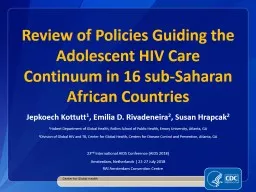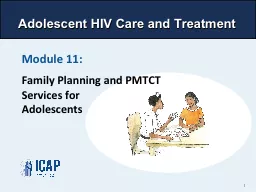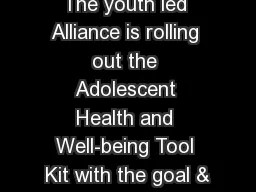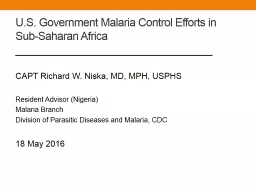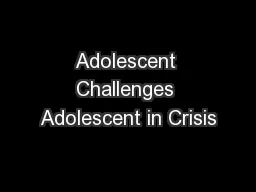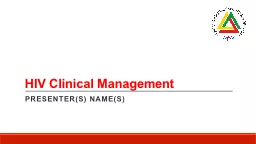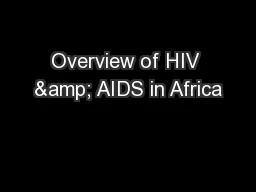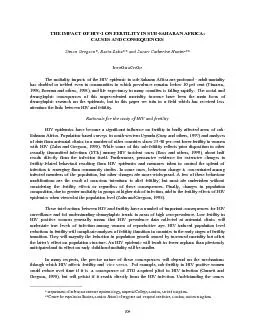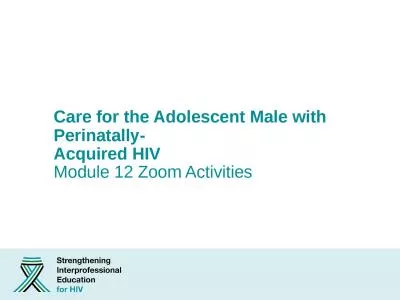PPT-Review of Policies Guiding the Adolescent HIV Care Continuum in 16 sub-Saharan African
Author : stefany-barnette | Published Date : 2019-11-21
Review of Policies Guiding the Adolescent HIV Care Continuum in 16 subSaharan African Countries Jepkoech Kottutt 1 Emilia D Rivadeneira 2 Susan Hrapcak 2 1 Hubert
Presentation Embed Code
Download Presentation
Download Presentation The PPT/PDF document "Review of Policies Guiding the Adolescen..." is the property of its rightful owner. Permission is granted to download and print the materials on this website for personal, non-commercial use only, and to display it on your personal computer provided you do not modify the materials and that you retain all copyright notices contained in the materials. By downloading content from our website, you accept the terms of this agreement.
Review of Policies Guiding the Adolescent HIV Care Continuum in 16 sub-Saharan African: Transcript
Review of Policies Guiding the Adolescent HIV Care Continuum in 16 subSaharan African Countries Jepkoech Kottutt 1 Emilia D Rivadeneira 2 Susan Hrapcak 2 1 Hubert Department of Global Health Rollins School of Public Health Emory University Atlanta GA. :. Making Every Opportunity Count. . Michele Dritz, MD, MS. Adolescent Medicine Clinic. Wright-Patterson AFB Medical Center. Overview. Background data on adolescent preventive care provision. Adolescent preventive care guidelines. Lawrence Edwards (UCT). Rhys Jenkins (UEA). GROWING INVOLVEMENT OF CHINA IN SUB-SAHARAN AFRICA. Trade links - total trade between China & SSA increased from US$7.5 bn. to US$113 bn. (2001-2011). WHAP. Mr. Sienkiewickz. WELCOME TO THE AMERICAN MEUSEUM OF NATURAL HISTORY. . Sub Saharan Africa in 6 Artifacts. Welcome to the new exhibit on Sub Saharan Africa. In the next 10 minutes I’ll be giving you a tour summarizing the history of Africa in 6 displays.. Sarah Saxon. Location. Sub-Saharan Africa lies south of the Sahara Desert- shaded green. Ceremonies. The . Bira. A Shona religious ceremony involving spirit possession. Mbira. players- musical specialists who perform at ceremony. Module 11:. Family Planning and PMTCT Services for Adolescents. 1. Module 11 Learning Objectives. After completing this module, participants will be able to:. . List the risks of adolescent pregnancy. By 2020 in Malawi policies, laws and strategies targeting the adolescents and young people will be up to date, harmonized and enforced in line with international, regional and national frameworks by 2020.. _________________________________. CAPT Richard W. Niska, MD, MPH, USPHS. Resident Advisor (Nigeria). Malaria Branch. Division of Parasitic Diseases and Malaria, CDC. 18 May 2016. What is malaria?. Parasite (. There are many issues that the adolescent faces in today’s American society that could bring on anxiety, present challenging problems, and/or require difficult decision-making. . Each individual may deal differently with these subjects. For some, the matter may be insignificant, while it becomes a crisis for others or their family. . Regional Capacity-Building Network. Based in Johannesburg, South Africa. Mission: Strengthen clinician capacity to deliver HIV, HBV, and HCV treatment . Partners include:. Supported through an educational grant from: . Dr . Flavia. Senkubuge. Specialist Public Health Medicine. University of Pretoria. 28 February 2011. Introduction. HIV&AIDS remains of Public Health concern in Africa. Significant strides made but much still to be achieved. CH. 18. I. Effects of Early African Migrations: Agriculture & Population Growth. Bananas. . - entered sea lanes by the Indian Ocean. . - Cultivation in Madagascar moved E. African mainland. . -Enabled Bantu to increase food supply, enrich diets, and expand. of the HIV fertility relationship is therefore an important precursor to understanding the consequences. Understanding sexual behaviour, a field which demographers have studied because of its importa HIV1 and slower to progress to AIDS.. Most cases are due to type1.. Modes of transmission. 1-sexual.. 2- perinatal.. 3-parenteral(occupational and intravenous drug injection).. 4- blood transfusion.. Acquired HIV. Module 12 Zoom Activities. #1: Multidisciplinary discussion . Objective: Explain the psychosocial and biomedical impact of perinatally-acquired HIV, and explore interprofessional interventions to address these issues (IPE) .
Download Document
Here is the link to download the presentation.
"Review of Policies Guiding the Adolescent HIV Care Continuum in 16 sub-Saharan African"The content belongs to its owner. You may download and print it for personal use, without modification, and keep all copyright notices. By downloading, you agree to these terms.
Related Documents

